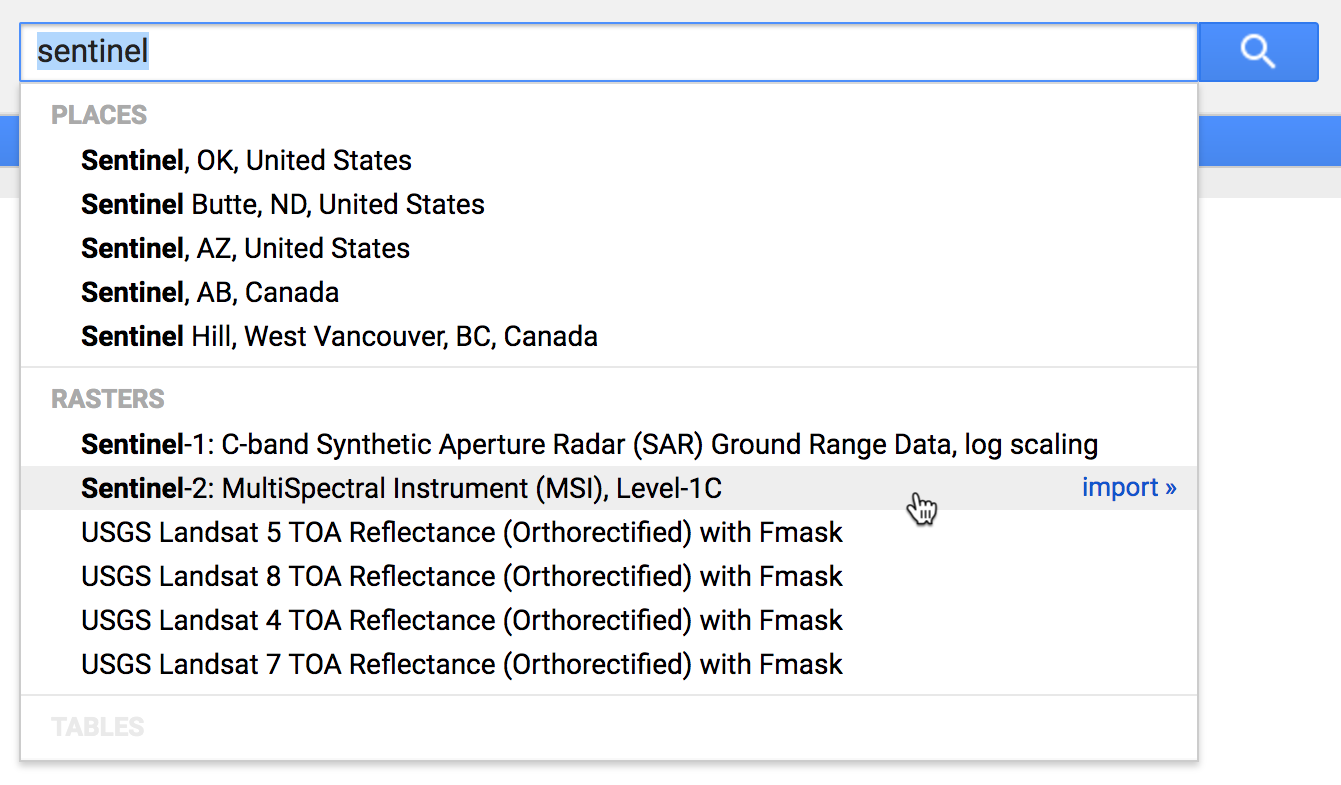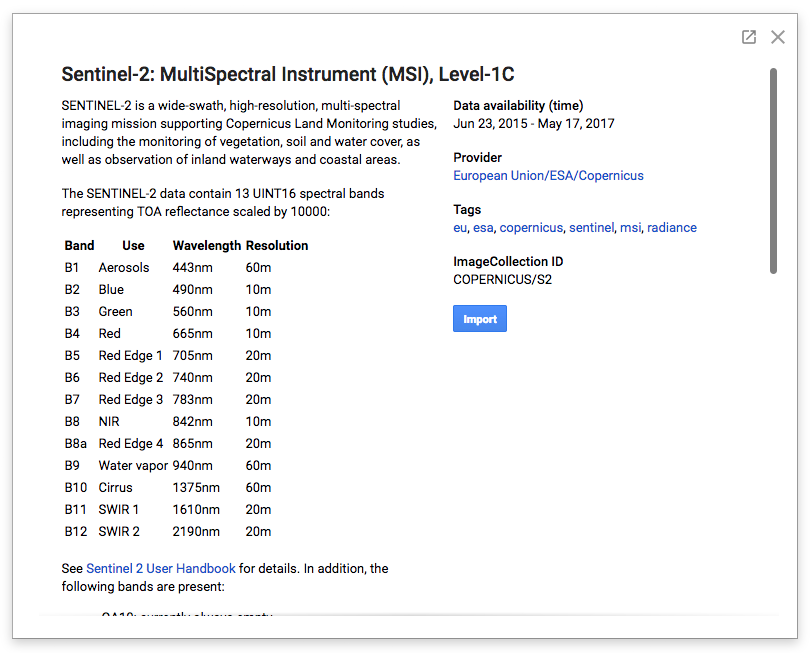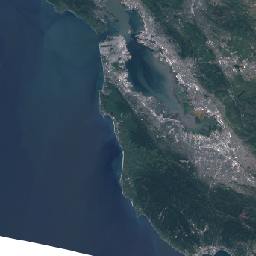本指南說明如何使用 Google Colab,從 Python 快速開始對 Earth Engine REST API 發出查詢。從其他語言和環境存取 API 時,也適用相同概念。
注意: REST API 包含許多新功能和進階功能,可能不適合所有使用者。如果您是 Earth Engine 新手,請先參閱 JavaScript 指南。
事前準備
請按照這些指示操作,以:
設定 Colab 筆記本
如果您要從頭開始進行這項快速入門導覽課程,可以按一下 Colab 開始頁面中的「新建筆記本」,建立新的 Colab 筆記本,然後在新程式碼儲存格中輸入下列程式碼範例。Colab 已安裝 Cloud SDK。包括可用來管理 Cloud 服務的 gcloud 指令列工具。或者,您也可以按一下本頁開頭的按鈕,執行示範筆記本。
向 Google Cloud 進行驗證
首先,請登入 Google Cloud,以便傳送經過驗證的要求。
在 Colab 中,您可以執行:
PROJECT = 'my-project' !gcloud auth login --project {PROJECT}
(或者,如果您是在本機執行,請從指令列執行,前提是您已安裝 Cloud SDK:)
PROJECT='my-project' gcloud auth login --project $PROJECT
使用 Google 使用者帳戶並接受登入選項,然後完成登入程序。
取得服務帳戶的私密金鑰檔案
如要使用服務帳戶進行驗證,請先下載私密金鑰檔案。如要在 Colab 中執行這項操作,請下載至筆記本 VM:
SERVICE_ACCOUNT='foo-name@project-name.iam.gserviceaccount.com' KEY = 'my-secret-key.json' !gcloud iam service-accounts keys create {KEY} --iam-account {SERVICE_ACCOUNT}
或者,您也可以透過指令列執行:
SERVICE_ACCOUNT='foo-name@project-name.iam.gserviceaccount.com' KEY='my-secret-key.json' gcloud iam service-accounts keys create $KEY --iam-account $SERVICE_ACCOUNT
存取及測試憑證
您現在可以向 Earth Engine API 傳送第一個查詢。使用私密金鑰取得憑證。使用憑證建立授權工作階段,發出 HTTP 要求。您可以在 Colab 筆記本的新程式碼儲存格中輸入這項指令。(如果您使用指令列,請務必安裝必要程式庫)。
from google.auth.transport.requests import AuthorizedSession from google.oauth2 import service_account credentials = service_account.Credentials.from_service_account_file(KEY) scoped_credentials = credentials.with_scopes( ['https://www.googleapis.com/auth/cloud-platform']) session = AuthorizedSession(scoped_credentials) url = 'https://earthengine.googleapis.com/v1alpha/projects/earthengine-public/assets/LANDSAT' response = session.get(url) from pprint import pprint import json pprint(json.loads(response.content))
如果一切設定正確,執行這項操作會產生如下所示的輸出內容:
{'id': 'LANDSAT',
'name': 'projects/earthengine-public/assets/LANDSAT',
'type': 'FOLDER'}
選擇資料集
您可以使用 Earth Engine 程式碼編輯器 (網址:code.earthengine.google.com) 搜尋及探索可用的資料集。現在來尋找一些 Sentinel 2 資料。(如果您是第一次使用程式碼編輯器,登入時系統會提示您授權程式碼編輯器代表您存取 Earth Engine)。在程式碼編輯器頂端的搜尋框中搜尋「sentinel」。系統會顯示數個點陣資料集:

按一下「Sentinel-2: MultiSpectral Instrument (MSI), Level-1C」:

這類資料集說明頁面包含使用 Earth Engine 公開資料目錄中任何資料集所需的重要資訊,包括資料集的簡要說明、資料供應商的連結 (可取得其他詳細資料)、可能適用於資料集的任何使用限制,以及資料集的 Earth Engine 資產 ID。
在本例中,視窗右側顯示這是路徑為 COPERNICUS/S2 的圖片集資產。
查詢特定圖片
這個 Sentinel-2 資料集包含 2015 年至今全球各地超過兩百萬張影像。讓我們對圖片集合發出 projects.assets.listImages 查詢,找出 2017 年 4 月雲量較低的部分資料,其中包含加州山景城某個特定點。
import urllib coords = [-122.085, 37.422] project = 'projects/earthengine-public' asset_id = 'COPERNICUS/S2' name = '{}/assets/{}'.format(project, asset_id) url = 'https://earthengine.googleapis.com/v1alpha/{}:listImages?{}'.format( name, urllib.parse.urlencode({ 'startTime': '2017-04-01T00:00:00.000Z', 'endTime': '2017-05-01T00:00:00.000Z', 'region': '{"type":"Point", "coordinates":' + str(coords) + '}', 'filter': 'CLOUDY_PIXEL_PERCENTAGE < 10', })) response = session.get(url) content = response.content for asset in json.loads(content)['images']: id = asset['id'] cloud_cover = asset['properties']['CLOUDY_PIXEL_PERCENTAGE'] print('%s : %s' % (id, cloud_cover))
這個指令碼會查詢集合中相符的圖片、解碼產生的 JSON 回應,並列印每個相符圖片資產的資產 ID 和雲層覆蓋率。輸出內容應如下所示:
COPERNICUS/S2/20170420T184921_20170420T190203_T10SEG : 4.3166
COPERNICUS/S2/20170430T190351_20170430T190351_T10SEG : 0
顯然這個月在這個地點拍攝的兩張圖片雲量較少。
檢查特定圖片
其中一個相符的影像雲量基本上為零。讓我們進一步瞭解 ID 為 COPERNICUS/S2/20170430T190351_20170430T190351_T10SEG 的素材資源。請注意,所有公開目錄資產都屬於專案 earthengine-public。以下是 Python 片段,會發出 projects.assets.get 查詢,依 ID 擷取特定資產的詳細資料、列印可用的資料頻帶,以及列印第一個頻帶的詳細資訊:
asset_id = 'COPERNICUS/S2/20170430T190351_20170430T190351_T10SEG' name = '{}/assets/{}'.format(project, asset_id) url = 'https://earthengine.googleapis.com/v1alpha/{}'.format(name) response = session.get(url) content = response.content asset = json.loads(content) print('Band Names: %s' % ','.join(band['id'] for band in asset['bands'])) print('First Band: %s' % json.dumps(asset['bands'][0], indent=2, sort_keys=True))
輸出內容應如下所示:
Band Names: B1,B2,B3,B4,B5,B6,B7,B8,B8A,B9,B10,B11,B12,QA10,QA20,QA60
First Band: {
"dataType": {
"precision": "INTEGER",
"range": {
"max": 65535
}
},
"grid": {
"affineTransform": {
"scaleX": 60,
"scaleY": -60,
"translateX": 499980,
"translateY": 4200000
},
"crsCode": "EPSG:32610",
"dimensions": {
"height": 1830,
"width": 1830
}
},
"id": "B1",
"pyramidingPolicy": "MEAN"
}
資料頻帶清單與我們稍早看到的資料集說明相符。我們可以發現,這個資料集在 EPSG:32610 座標系統 (或 UTM Zone 10N) 中有 16 位元整數資料。這個第一個波段的 ID 為 B1,解析度為每像素 60 公尺。在此座標系統中,圖片原點位於 (499980,4200000)。
affineTransform.scaleY 的負值表示原點位於圖片的西北角 (通常是這種情況):增加 y 像素索引會對應到減少 y 空間座標 (朝南)。
擷取 Pixel 值
我們來發出 projects.assets.getPixels 查詢,從這張圖片的高解析度頻帶擷取一些資料。資料集說明頁面指出,頻帶 B2、B3、B4 和 B8 的解析度為每像素 10 公尺。這項指令碼會從這四個波段擷取左上方的 256x256 像素資料圖塊。以 numpy NPY 格式載入資料,可輕鬆將回應解碼為 Python 資料陣列。
import numpy import io name = '{}/assets/{}'.format(project, asset_id) url = 'https://earthengine.googleapis.com/v1alpha/{}:getPixels'.format(name) body = json.dumps({ 'fileFormat': 'NPY', 'bandIds': ['B2', 'B3', 'B4', 'B8'], 'grid': { 'affineTransform': { 'scaleX': 10, 'scaleY': -10, 'translateX': 499980, 'translateY': 4200000, }, 'dimensions': {'width': 256, 'height': 256}, }, }) pixels_response = session.post(url, body) pixels_content = pixels_response.content array = numpy.load(io.BytesIO(pixels_content)) print('Shape: %s' % (array.shape,)) print('Data:') print(array)
輸出內容應如下所示:
Shape: (256, 256)
Data:
[[( 899, 586, 351, 189) ( 918, 630, 501, 248) (1013, 773, 654, 378) ...,
(1014, 690, 419, 323) ( 942, 657, 424, 260) ( 987, 691, 431, 315)]
[( 902, 630, 541, 227) (1059, 866, 719, 429) (1195, 922, 626, 539) ...,
( 978, 659, 404, 287) ( 954, 672, 426, 279) ( 990, 678, 397, 304)]
[(1050, 855, 721, 419) (1257, 977, 635, 569) (1137, 770, 400, 435) ...,
( 972, 674, 421, 312) (1001, 688, 431, 311) (1004, 659, 378, 284)]
...,
[( 969, 672, 375, 275) ( 927, 680, 478, 294) (1018, 724, 455, 353) ...,
( 924, 659, 375, 232) ( 921, 664, 438, 273) ( 966, 737, 521, 306)]
[( 920, 645, 391, 248) ( 979, 728, 481, 327) ( 997, 708, 425, 324) ...,
( 927, 673, 387, 243) ( 927, 688, 459, 284) ( 962, 732, 509, 331)]
[( 978, 723, 449, 330) (1005, 712, 446, 314) ( 946, 667, 393, 269) ...,
( 949, 692, 413, 271) ( 927, 689, 472, 285) ( 966, 742, 516, 331)]]
如要從這張圖片選取其他像素集,只要指定 affineTransform 即可。請注意,affineTransform 是在圖片的空間座標參考系統中指定;如要改為調整像素座標中的原點位置,請使用以下簡單公式:
request_origin = image_origin + pixel_scale * offset_in_pixels
生成縮圖
我們可以運用類似機制,生成這張圖片的 RGB 縮圖。我們會明確指定區域和圖片尺寸,而非要求原始解析度的資料。如要取得整張圖片的縮圖,我們可以將圖片的足跡幾何圖形做為要求區域。最後,指定紅色、綠色和藍色影像頻帶,以及適當的資料值範圍,即可取得美觀的 RGB 縮圖影像。
綜合以上內容,Python 程式碼片段如下 (使用 Colab IPython 圖片顯示小工具):
url = 'https://earthengine.googleapis.com/v1alpha/{}:getPixels'.format(name) body = json.dumps({ 'fileFormat': 'PNG', 'bandIds': ['B4', 'B3', 'B2'], 'region': asset['geometry'], 'grid': { 'dimensions': {'width': 256, 'height': 256}, }, 'visualizationOptions': { 'ranges': [{'min': 0, 'max': 3000}], }, }) image_response = session.post(url, body) image_content = image_response.content from IPython.display import Image Image(image_content)
以下是產生的縮圖:


 在 Google Colab 中執行
在 Google Colab 中執行
 在 GitHub 上查看來源
在 GitHub 上查看來源